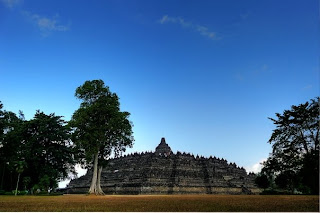Borobudur Tample is constructed as a ten-terraces building. The height before being renovated was 42 meters and 34.5 meters after the renovation because the lowest level was used as supporting base. The first six terraces are in square form, two upper terraces are in circular form, and on top of them is the terrace where Buddha statue is located facing westward. Each terrace symbolizes the stage of human life. In line with of Buddha Mahayana, anyone who intends to reach the level of Buddha's must go through each of those life stages.
Each terrace has beautiful relief panels showing how skillful the sculptors were. In order to understand the sequence of the stories on the relief panels, you have to walk clockwise from the entrance of the temple. The relief panels tell the legendary story of Ramayana. Besides, there are relief panels describing the condition of the society by that time; for example, relief of farmers' activity reflecting the advance of agriculture system and relief of sailing boat representing the advance of navigation in Bergotta (Semarang).
All relief panels in Borobudur temple reflect Buddha's teachings. For the reason, this temple functions as educating medium for those who want to learn Buddhism. My suggests that you walk through each narrow passage in Borobudur in order for you to know the philosophy of Buddhism. Atisha, a Buddhist from India in the tenth century once visited this temple that was built 3 centuries before Angkor Wat in Cambodia and 4 centuries before the Grand Cathedrals in Europe.
 |
| In Java Mitoligi if you can hold the middle finger of all his ideals will be achieved |
A question about Borobudur that is still unanswered by far is how the condition around the temple was at the beginning of its foundation and why at the time of it's finding the temple was buried. Some hypotheses claim that Borobudur in its initial foundation was surrounded by swamps and it was buried because of Merapi explosion. It was based on Kalkutta inscription with the writing 'Amawa' that means sea of milk. The Sanskrit word was used to describe the occurrence of disaster. The sea of milk was then translated into Merapi lava. Some others say that Borobudur was buried by cold lava of Merapi Mountain.
 |
| One of the existing statue of Buddha in temple |

 11:33 PM
11:33 PM
 Best Info
Best Info


 Posted in:
Posted in: 











0 comments:
Post a Comment